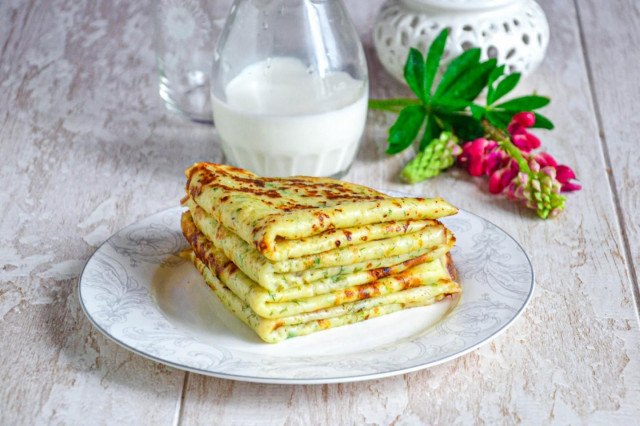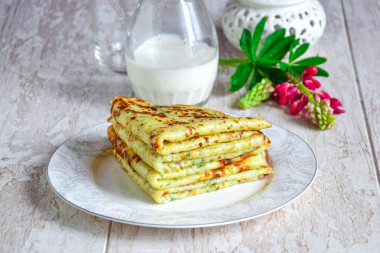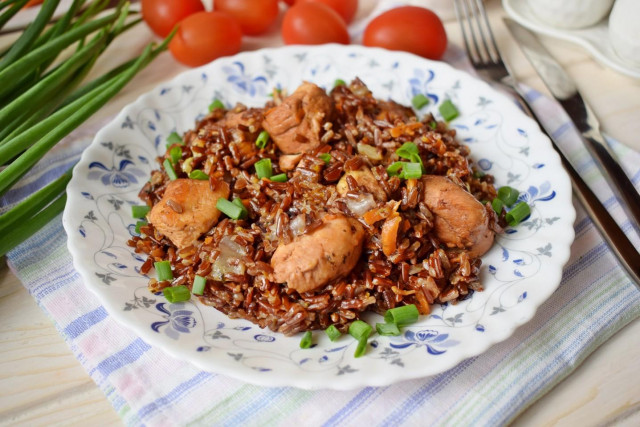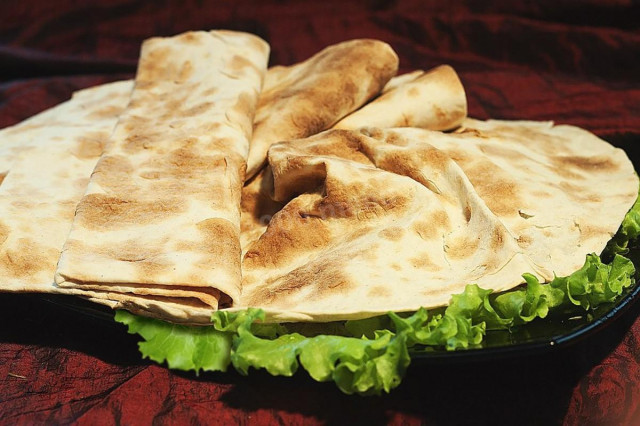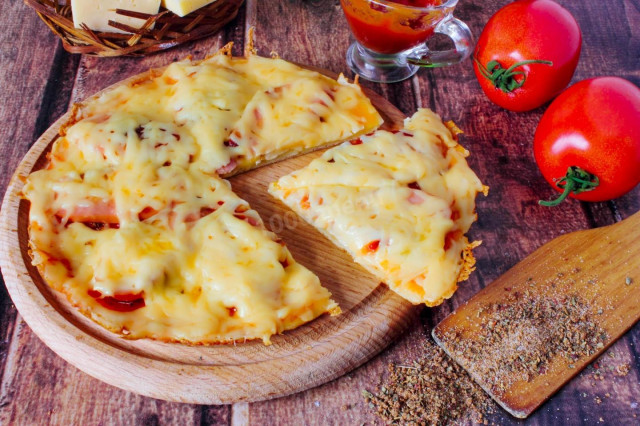Composition / ingredients
Step-by-step cooking
Step 1:
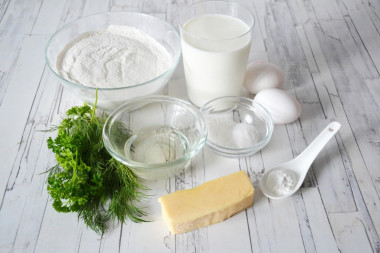
How to make cheese pancakes with greens? Prepare the products. Take milk of any fat content, it does not matter. Cheese for this dish is suitable solid or semi-solid. The main thing is that it is delicious, high-quality, without milk fat substitutes and melts well. You can take any greens that you like or that are available.
Step 2:

Beat the eggs into a bowl. Be sure to wash the eggs before use, as even the seemingly clean shell may contain harmful bacteria. It is best to use food detergents and a brush. Add sugar, salt and whisk everything together with a whisk until smooth.
Step 3:

Heat the milk slightly and pour it into the beaten eggs. Mix everything with a whisk. On warm milk, the dough turns out to be more homogeneous — flour will be better diluted in it.
Step 4:

Sift flour with baking powder. It is important to sift the flour to saturate it with oxygen. Then the baking will turn out to be airy and will rise well when baking.
Step 5:
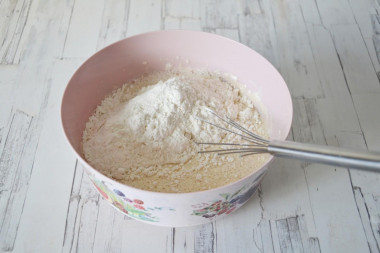
Gradually, in several steps, add the sifted flour to the dough. After each addition, mix the dough well with a whisk or mixer.
Step 6:
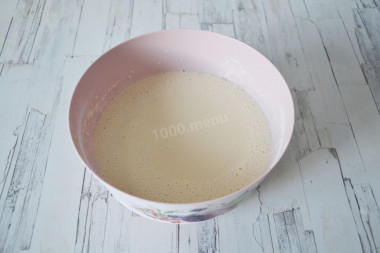
The dough should be homogeneous, without lumps and quite liquid, like on ordinary thin pancakes.
Step 7:
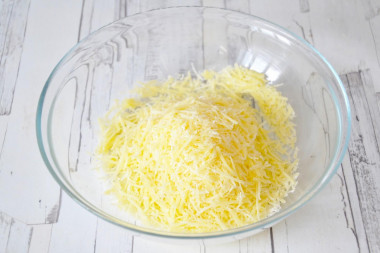
Grate the cheese on a fine grater.
Step 8:

Wash the dill and parsley (or other herbs), dry and finely chop.
Step 9:
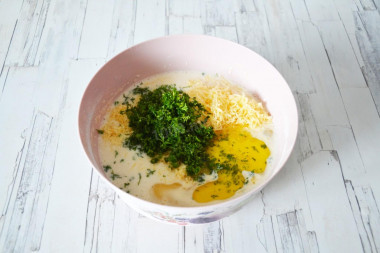
Add grated cheese, chopped herbs and vegetable oil to the pancake batter.
Step 10:
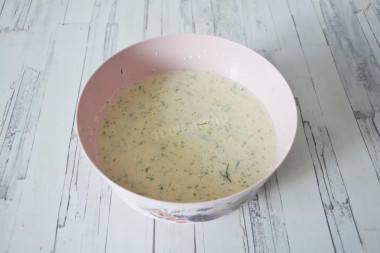
Stir. If the dough is too thick as a result, you can dilute it with warm milk or water.
Step 11:

Fry the cheese pancakes in a hot frying pan until golden brown on both sides. There is no need to lubricate the pan, since the dough already contains vegetable oil. But before the first pancake, still smear it with a small amount so that it does not come out lumpy.
Step 12:
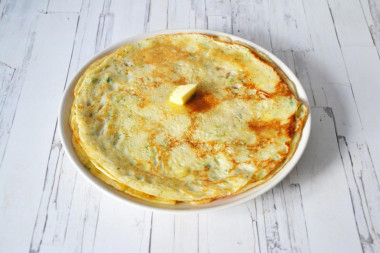
Stack the finished pancakes on top of each other, liberally smearing them with butter.
Step 13:
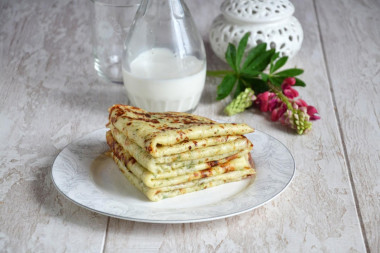
Serve these pancakes with sour cream. Delicious with warm milk. Bon appetit!
Tender and fragrant pancakes with cheese and herbs can be served with sour cream or made the basis of a snack pancake cake, for example, from boiled chicken or fried mushrooms.
Researching Russian life and traditions, historian V. Pohlebkin came to the conclusion that the name of the dish comes from the form of the word grind, "mlin". Literally, "pancake" can mean a product made of flour, which is completely true. Historically, the highest quality products were used to prepare the dish.
The thing is that pancakes, as well as kutya, were intended for commemoration of the deceased. They were baked in large quantities and distributed to people with a small income, so that they, in turn, tasted the delicacy and remembered the deceased. Later, closer to the IX century, pancakes became the main dish of the Maslenitsa holiday, which is also a kind of wake or send-off of winter. Although, there is another version that they resemble the spring sun in color and shape and are a symbol of the main Slavic deity, Yarilo.
Be prepared for the fact that flour may need more or less than indicated in the recipe. Focus not on the amount of flour, but on the desired consistency of the dough. To avoid mistakes, read about flour and its properties!
Important! An incorrectly selected frying pan can spoil even the best recipe. All the details on how to choose the perfect frying pan for different dishes read here .
Is it possible to replace baking powder with soda, how to add them correctly so that the baking is lush, how to avoid an unpleasant soda taste and much more, read the article "Baking powder or baking soda - which is better?"
Calorie content of the products possible in the dish
- Whole cow's milk - 68 kcal/100g
- Milk 3.5% fat content - 64 kcal/100g
- Milk 3.2% fat content - 60 kcal/100g
- Milk 1.5% fat content - 47 kcal/100g
- Concentrated milk 7.5% fat content - 140 kcal/100g
- Milk 2.5% fat content - 54 kcal/100g
- Chicken egg - 157 kcal/100g
- Egg white - 45 kcal/100g
- Egg powder - 542 kcal/100g
- Egg yolk - 352 kcal/100g
- Ostrich egg - 118 kcal/100g
- Dutch cheese - 352 kcal/100g
- Swiss cheese - 335 kcal/100g
- Russian cheese - 366 kcal/100g
- Kostroma cheese - 345 kcal/100g
- Yaroslavsky cheese - 361 kcal/100g
- Altai cheese 50% fat content - 356 kcal/100g
- Soviet cheese - 400 kcal/100g
- Cheese "steppe" - 362 kcal/100g
- Uglich cheese - 347 kcal/100g
- Poshekhonsky cheese - 350 kcal/100g
- Lambert cheese - 377 kcal/100g
- Appnzeller cheese with 50% fat content - 400 kcal/100g
- Chester cheese with 50% fat content - 363 kcal/100g
- Edamer cheese with 40% fat content - 340 kcal/100g
- Cheese with mushrooms of 50% fat content - 395 kcal/100g
- Emmental cheese with 45% fat content - 420 kcal/100g
- Gouda cheese with 45% fat content - 356 kcal/100g
- Aiadeus cheese - 364 kcal/100g
- Dom blanc cheese (semi-hard) - 360 kcal/100g
- Cheese "lo spalmino" - 61 kcal/100g
- Cheese "etorki" (sheep, hard) - 401 kcal/100g
- White cheese - 100 kcal/100g
- Fat yellow cheese - 260 kcal/100g
- Altai cheese - 355 kcal/100g
- Kaunas cheese - 355 kcal/100g
- Latvian cheese - 316 kcal/100g
- Limburger cheese - 327 kcal/100g
- Lithuanian cheese - 250 kcal/100g
- Lake cheese - 350 kcal/100g
- Gruyere cheese - 396 kcal/100g
- Parsley greens - 45 kcal/100g
- Dill greens - 38 kcal/100g
- Whole durum wheat flour fortified - 333 kcal/100g
- Whole durum wheat flour, universal - 364 kcal/100g
- Flour krupchatka - 348 kcal/100g
- Flour - 325 kcal/100g
- Granulated sugar - 398 kcal/100g
- Sugar - 398 kcal/100g
- Vegetable oil - 873 kcal/100g
- Salt - 0 kcal/100g
- Baking powder dough - 79 kcal/100g

